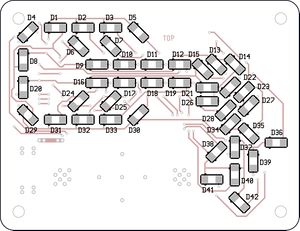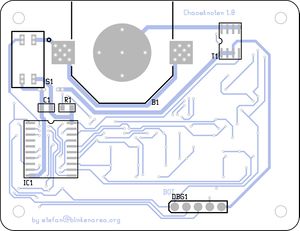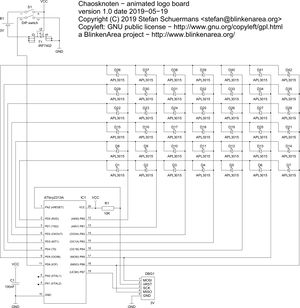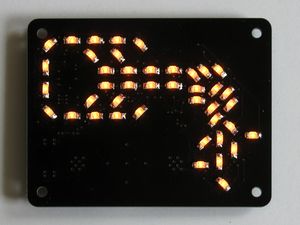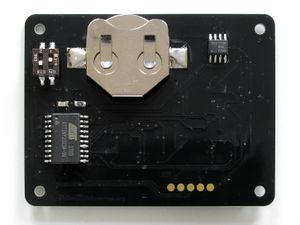ChaosknotenEnglish: Difference between revisions
No edit summary |
(Chaosknoten English finished) |
||
| Line 12: | Line 12: | ||
}} | }} | ||
Chaosknoten - this is a small circuit board of 65 x 50mm, which uses 42 LEDs to show the official logo of [https://de.wikipedia.org/wiki/Chaos_Computer_Club logo of Chaos Computer Club]. The orange LEDs display several animations using 16 brightness levels (gamma = 2.0). | Chaosknoten - this is a small circuit board of 65 x 50mm, which uses 42 LEDs to show the official logo of [https://de.wikipedia.org/wiki/Chaos_Computer_Club logo of Chaos Computer Club]. The orange LEDs can display several animations using 16 brightness levels (gamma = 2.0). The board is powered by a single CR2032 button cell. On the backside there are two switches - one to turn it on and off, and the other one can be used to replay the currently shown animation in infinite loop. Otherwise all animations in memory are played in sequence repetitive. If you have only one animation in memory, the switch has no effect. | ||
The logo is designed by [https://de.wikipedia.org/wiki/Wau_Holland Wau Holland]. We are authorized by the [https://www.wauland.de/ Wau Holland Stiftung] to provide this kit as long as we don't make any profit with it and we provide the layout information and software for free. | The logo is designed by [https://de.wikipedia.org/wiki/Wau_Holland Wau Holland]. We are authorized by the [https://www.wauland.de/ Wau Holland Stiftung] to provide this kit as long as we don't make any profit with it and we provide the layout information and software for free. | ||
This project | This project is based on the [[bulb]]. | ||
=== Downloads (firmware, layout, circuit layout) === | === Downloads (firmware, layout, circuit layout) === | ||
| Line 22: | Line 22: | ||
* [https://git.blinkenarea.org/?p=Chaosknoten Blinkenarea Chaosknoten GIT-Repository] | * [https://git.blinkenarea.org/?p=Chaosknoten Blinkenarea Chaosknoten GIT-Repository] | ||
==== | ==== firmware, layout, circuit layout ==== | ||
* [[Media:Chaosknoten-1.0.pdf|Chaosknoten-Anleitung 1.0.0 (PDF file)]] | * [[Media:Chaosknoten-1.0.pdf|Chaosknoten-Anleitung 1.0.0 (PDF file)]] | ||
| Line 40: | Line 40: | ||
<li style="display: inline-block;"> [[File:BlinkenArea-CCC-Chaosknoten_(front).jpg|thumb|none|Chaosknoten front]] </li> | <li style="display: inline-block;"> [[File:BlinkenArea-CCC-Chaosknoten_(front).jpg|thumb|none|Chaosknoten front]] </li> | ||
<li style="display: inline-block;"> [[File:BlinkenArea-CCC-Chaosknoten_(back).jpg|thumb|none|Chaosknoten back]] </li> | <li style="display: inline-block;"> [[File:BlinkenArea-CCC-Chaosknoten_(back).jpg|thumb|none|Chaosknoten back]] </li> | ||
# Open the [[Media:Chaosknoten-1.0.pdf|Chaosknoten Instructions]] | === Instructions for assembling the kit in 10 steps === | ||
# Open the [[Media:Chaosknoten-1.0.pdf|Chaosknoten Instructions]] and read pages 1 and 2 of the instructions, try to understand it and check if you have the complete list of parts. | |||
# Solder the LEDs onto the front side as shown in the layout diagram on page 2. The black dots beside the LEDs in the diagram show you, where the green dots on the real LEDs shall point to. Your Soldering iron should have a temperature about 350 °C. | # Solder the LEDs onto the front side as shown in the layout diagram on page 2. The black dots beside the LEDs in the diagram show you, where the green dots on the real LEDs shall point to. Your Soldering iron should have a temperature about 350 °C. | ||
# Look at the layout of the backside on page 2 in the instructions. | # Look at the layout of the backside on page 2 in the instructions. | ||
# Take the resistor (tiny, dark, "1002" imprinted) and solder it on the position "Rq". The polarity (direction) doesn't matter. | # Take the resistor (tiny, dark, "1002" imprinted) and solder it on the position "Rq". The polarity (direction) doesn't matter. | ||
# Solder the compasitor (tiny, brown, no imprint) on position "C1". The polarity (direction) doesn't matter. | # Solder the compasitor (tiny, brown, no imprint) on position "C1". The polarity (direction) doesn't matter. | ||
# FET ( | # Solder the field-effect transistor (FET) (small, black, 8 pins) on position "T1". The dot on the chip points to the direction which is marked with a yellow semicircle in the instructions. | ||
# | # Solder the microcontroller (bigger, black, 20 pins) on posiciton "IC1". The dot on the chip shall point in the same direction as the semicircle in the instructions. | ||
# | # Solder the switch (black, two small levers, 4 pins) on position "S1". The small ring marks pin 1 of the switch. Pin 1 is where in the instructions the component has the mark "1". | ||
# | # Solder the battery holder on Position "B1" | ||
# | # insert the battery | ||
[[Category:Projekte]] | [[Category:Projekte]] | ||
Revision as of 11:55, 22 June 2019
| project overview | |
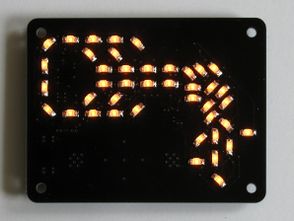
| |
| Year | 2019 |
| Number of pixels | 42 |
| Grayscales / Colors | 16 Graustufen (gamma 2.0) |
| Illuminant | SMD LEDs |
| Power input | 120mW |
| Contact person | Stefan Schuermans, ST |
| Project website | BlinkenArea Chaosknoten |
Chaosknoten - this is a small circuit board of 65 x 50mm, which uses 42 LEDs to show the official logo of logo of Chaos Computer Club. The orange LEDs can display several animations using 16 brightness levels (gamma = 2.0). The board is powered by a single CR2032 button cell. On the backside there are two switches - one to turn it on and off, and the other one can be used to replay the currently shown animation in infinite loop. Otherwise all animations in memory are played in sequence repetitive. If you have only one animation in memory, the switch has no effect.
The logo is designed by Wau Holland. We are authorized by the Wau Holland Stiftung to provide this kit as long as we don't make any profit with it and we provide the layout information and software for free.
This project is based on the bulb.
Downloads (firmware, layout, circuit layout)
firmware, layout, circuit layout
Images
- Open the Chaosknoten Instructions and read pages 1 and 2 of the instructions, try to understand it and check if you have the complete list of parts.
- Solder the LEDs onto the front side as shown in the layout diagram on page 2. The black dots beside the LEDs in the diagram show you, where the green dots on the real LEDs shall point to. Your Soldering iron should have a temperature about 350 °C.
- Look at the layout of the backside on page 2 in the instructions.
- Take the resistor (tiny, dark, "1002" imprinted) and solder it on the position "Rq". The polarity (direction) doesn't matter.
- Solder the compasitor (tiny, brown, no imprint) on position "C1". The polarity (direction) doesn't matter.
- Solder the field-effect transistor (FET) (small, black, 8 pins) on position "T1". The dot on the chip points to the direction which is marked with a yellow semicircle in the instructions.
- Solder the microcontroller (bigger, black, 20 pins) on posiciton "IC1". The dot on the chip shall point in the same direction as the semicircle in the instructions.
- Solder the switch (black, two small levers, 4 pins) on position "S1". The small ring marks pin 1 of the switch. Pin 1 is where in the instructions the component has the mark "1".
- Solder the battery holder on Position "B1"
- insert the battery
